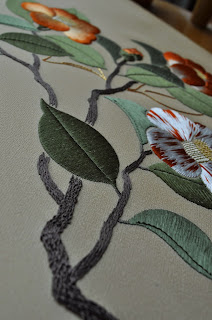You could be forgiven for thinking that I have not done any
Japanese Embroidery in the last 12 months and you would not be far from wrong!
A quick review of the year gives some indication as to why JE has taken a back seat. Last winter I was focused on completing my
Phase V Japanese beading and up until March this year nearly all of my stitching time was dedicated to that. I finished that in March, just before I went to my five day JE class in Bournemouth where I made a good start on my next phase piece. I should have used that momentum to get back into a stitching regime but I got distracted by other things. The problem is I’m jist a girl who cain’t say no … to embroidery projects that is. There have been so many temptations this year that I have not been able to resist. I’ve written about some of them in the last few posts but there have been several more that I have not had time to stitch. They have been added to the stash for a later date.
© JEC/Carol-Anne Conway
But there is another thing that has been preventing me from getting on with my Japanese embroidery … Fear of Failure!
When I began learning JE in 2005, I wasn’t thinking about doing all ten phases, I just wanted to learn this exquisite form of embroidery. As one class became two, then three, and my love of JE grew, so did my desire to complete all nine phases so that one day, just maybe, I might be able to go to Phase X class in Atlanta. But I hardly dared hope it would actually happen.
© JEC/Carol-Anne Conway
Nearly eight years ago, when I started to write about Japanese embroidery on my blog, I wondered if anyone else was blogging about JE. After searching the internet I found only one other person, Susan Elliot of
Plays With Needles. When I first found her blog, Susan’s
latest post was about a piece affectionately known to JEC students as ‘Gracie’. I returned to Susan’s blog frequently, hoping for an update but I had a long wait. What I didn’t know then was that
life had thrown Susan a curve ball and it would be some 18 months before she would post again.
In the years since, Susan’s blog has become one of my favourite places on the internet and we have become good friends. We share several ambitions and hope that life will afford us the opportunity to undertake some of them together. In fact, we have made a pact to realise the first of those ambitions,
we are both working towards completing Phases I – IX so that we can attend Phase X class together in Atlanta.
© JEC/Carol-Anne Conway
Initially, we spoke about going to Atlanta in 2014 but we realised that was not a realistic goal for either of us so we are aiming for 2015. To be honest, I am not sure that I can achieve all that I need to in order to meet this deadline and that is what I am afraid of failing at. The stupid thing is that instead of knuckling down while this was a realistic goal, I have let time whittle away and now I have a huge mountain to climb.
Since Sue’s illness, trying to do any Japanese embroidery just filled me with sadness but three weeks ago I attended class in Garstang. There, surround by friends and people who loved Sue, I refound my JE mojo. The first two days were very painful but I found the
tears and laughter on the Saturday very cathartic. Since returning from Garstang, I have renewed my commitment to stitch for at least 15 minutes every day and have been making slow but steady progress with Phase IX. I still have a huge mountain to climb … but I have started climbing!
© JEC/Carol-Anne Conway
If you have ever wanted to learn Japanese embroidery, my tutor in Garstang, Denise Foster, is now teaching JE at
Missenden Abbey in Buckinghamshire. She has two 2-day courses scheduled for the weekends of
January 24-25 2015 and
May 2-3 2015 - ideal for beginners as well as experienced Japanese embroidery students. What could be better than a weekend away from the household chores, having someone else cook your meals and make your bed while you spend your days stitching?
Happy Stitching





















































